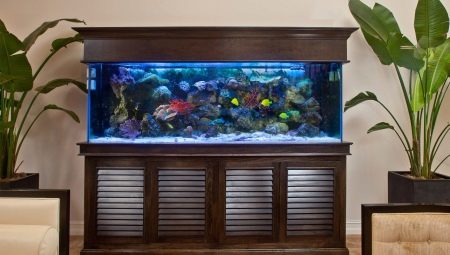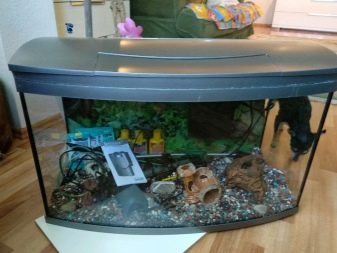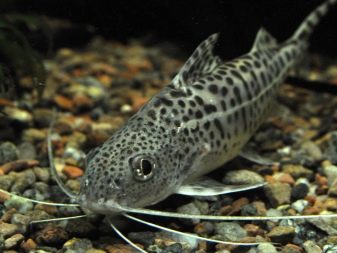100 liter aquariums: sizes, how many fish can you keep and which ones are right?

A hundred-liter aquarium is quite often recommended for purchase by aquarists, especially if several species of underwater pets are to be populated. However, before buying a rather expensive design, you should study all its features.

Advantages and disadvantages
A 100 liter aquarium allows you to accommodate many different types of inhabitants, since a large volume and the presence of full-fledged several layers is sufficient.
Moreover, fish, snails, and a variety of plants can be perfectly combined in one tank.
The relative disadvantage of the capacity is its bulkiness. - the apartment will have to allocate a fairly large space in order not only to beautifully place the object, but also to provide free access to it.

Variants of shapes and sizes
All aquariums are usually divided into several groups in accordance with the shape, which is also typical for 100-liter tanks. The first group includes classic rectangular and rather narrow containers. They are most popular due to their small size and the ability to observe underwater life. Panoramic aquariums can be easily confused with regular rectangular aquariums, but their characteristic feature is the presence of a curved front side. Thanks to such a surface, the viewing of pets becomes much more convenient and pleasant.
The cylindrical aquarium provides an even better view for the aquarist, and the ball-shaped tanks become a full-fledged decoration of any interior.


Wide rectangular containers are usually used for arranging terrariums or insect dwellings.Finally, corner aquariums are subdivided into oval panoramic and straight. In addition to their unusual appearance, their advantages include the ability to fill the corner of the room and thereby leave a lot of free space in the room. Of course, you can order an aquarium of an unusual shape, but you will have to first find specialists in their field and pay a large sum.
The parameters of a 100-liter aquarium are determined depending on the shape, but a rectangular container, as a rule, is 750 millimeters long, 450 millimeters high, and 300 millimeters wide. The optimum glass thickness is 6 millimeters. The average weight of the aquarium corresponds to 23 kilograms, although sometimes it weighs more and less.


How to choose?
There are several important aspects to consider when choosing the most suitable aquarium for your situation. First of all, the purpose of the purchase is determined - whether only fish, insects or, for example, turtles will be kept in the tank. Some people acquire unusual shaped aquariums just for decoration and place floral arrangements inside. Next, it is better to think about where the purchase can be placed. Since the 100 liter tank is so outstanding, the amount of free space determines the form of purchase. Next, the amount that can be spent for this purpose is calculated, and then the available offers on the market are studied.
It is important to understand that the cost of a 100 liter aquarium is quite high. The tank can be purchased both complete and "naked". As a result, the price will fluctuate from 1.5 to 7 thousand rubles.


Some exclusive models cost up to 50 thousand rubles. The company producing the aquarium also plays an important role. The more famous the company, the more money you have to pay.
The cost of a 100 liter aquarium can vary, even depending on its shape. Rectangular containers are much easier to manufacture and therefore have the lowest prices. Next, in order to increase the price tag, panoramic structures follow, and then corner models. The quality of the glass used and its thickness, as well as the manufacturing technology, affect the cost. The most expensive are the aquariums made by solid casting.

Where to install?
It is necessary to set up the aquarium in such a way that it is naturally illuminated, but not exposed to direct rays. The place should be reliable and stable, but allow you to calmly carry out general cleaning, change the water or feed the pets. A good place is the side opposite to the window opening. It's good if there is a socket nearby for connecting existing equipment: a filter, a heater, a compressor and the same lamp.
For safety, the level of the outlets should be higher than the level of the aquarium itself, since water ingress threatens to burn electrical wiring.


Easy access to water is also a plus as it greatly simplifies the water change procedure. Do not place the tank near a TV or computer, as fish react poorly to noise.
How to equip?
Setting up an aquarium is impossible without a high-quality internal filter, which costs about 1200 rubles. In order to save money, it can also be used for aeration, but it is much better to immediately purchase a compressor. Besides, a tank with a volume of 100 liters will need high-quality lighting... A classic rectangular aquarium requires two 18-watt T8 lamps. The luminaire is designed using incandescent, halogen, fluorescent or metal halide lamps.

Each of the varieties has its own pros and cons.
Light can also be reproduced thanks to LED lamps, but only as additional lighting or night illumination, since their power is rather low. It is necessary to calculate the number of lamps correctly, taking into account the needs of not only fish, but also mainly plants developing in the tank. When picking up light bulbs, it is important to keep track of the level to which the water is collected so that problems do not arise.

How many and what kind of fish can you keep?
The number of aquarium fish that can be placed in the tank depends on their species. Moreover, the exact figure is determined depending not only on the size of the creature, but also on its disposition, as well as the degree of aggressiveness. For example, for 100 liters of water, you can have 45 guppies or just one shark barbus. The possible number of pink zebrafish is 20, the same as the number of cardinals. Only 2 pieces of goldfish can live in the aquarium, while chocolate gourami will accommodate as many as 18 individuals. Betta cockerels will fit as many as 32 pieces, and the scalar can only live alone. In general, it is recommended to check this information in the store where the inhabitants of the aquarium are purchased.
It is important to remember that the increased density of the inhabitants of the aquarium, on the one hand, reduces aggression, but, on the other hand, slows down the development of fish and stops spawning.

In addition, numerous diseases are likely, as well as outbreaks of invasion. It is better to populate all the pets in a 100-liter aquarium at the same time, since new neighbors almost always endure the aggression of old-timers for the first time. In addition, when choosing fish, it is important to consider not only their current size, but also the maximum dimensions that they can achieve. For approximately every centimeter of fish, there should be 3 to 4 liters of water.
In a 100-liter aquarium, you can accommodate inhabitants of all three layers of water - upper, middle and bottom. As a rule, there are creatures at the top, the mouth of which looks up, and in the middle layer there are fish, the mouth of which is directed along the midline of the body. In the bottom layer, you can settle a speckled catfish, the length of which does not exceed 6 centimeters. The mobile fish has a friendly character and is used to living in a flock.

When setting up an aquarium for catfish, it is imperative to place enough shelters and plants so that the creatures have the opportunity to hide and take a break from their neighbors.
Another suitable animal is the golden catfish, which has similar characteristics, but is more thermophilic, as well as the ancistrus catfish, the size of which is already in the range of 12 to 15 centimeters. In the middle layer, experts recommend settling barbs, and of several types. Alternatively, it can be a cherry barb, which grows in length up to 5 centimeters. While giving preference to this species, it is important to understand that they are considered to be rather shy creatures that live in a flock. It is imperative to settle at least 7 individuals with a predominant number of females in the aquarium, and also make sure that they do not have sluggish neighbors. The size of the body is about 5 centimeters. Another suitable variety is the five-striped barb.


A little higher can be inhabited by gourami - both one and several species. Gourami marble is very calm and even slow. It should be stocked either in pairs or in a flock of 5 to 7 individuals.
To prevent the gourami from eating small fish, they will have to be settled only with creatures of the same size - 11 centimeters long. Gourami require both free spaces and floating plants to build nests and ground shelters. Pearl gourami are also suitable for an aquarium.
Guppies always show themselves well, especially since they are able to inhabit any layers of the aquarium. For a start, it is better to choose the classic version, and then acquire more capricious individuals. Guppies are not recommended to be populated together with predators or creatures showing aggression.

In general, these fish are distinguished by a positive character and a 6-centimeter body size.
The selection of the inhabitants of the aquarium is carried out in such a way that there is an overlap in requirements regarding water temperature and its composition. Warm-water and cold-water fish cannot live together. Inhabitants with different temperaments should live in different layers of the tank. If we talk not only about fish, but also about snails, then it makes sense to purchase neretina in a 100-liter aquarium. Its size is only 2 centimeters, and algae form the basis of nutrition, which keeps all plants safe. The latter can be absolutely any, but give preference to reasonably unpretentious ferns, salvinia or hygrophilia.
An overview of the 100 liter aquarium in the video below.








